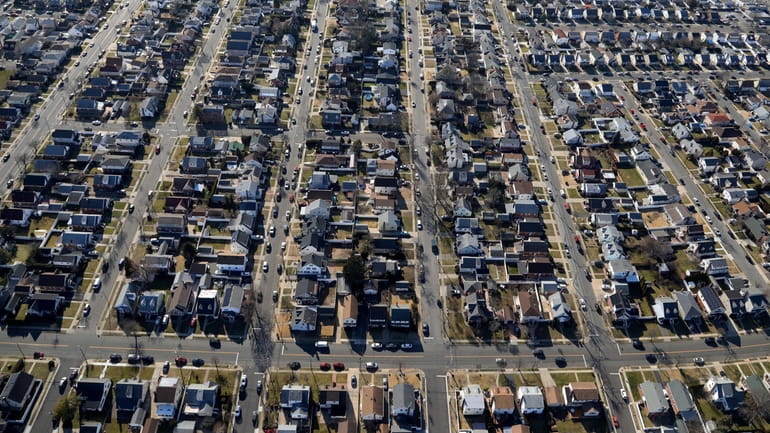U.S. mortgage rate shows biggest one-week drop since 1981

The national average rate for 30-year mortgages dropped almost half a percentage point. Credit: Newsday / John Keating
The average rate for a 30-year fixed mortgage fell by nearly one-half of a percentage point compared with last week, the largest one-week decline since 1981, according to data from mortgage giant Freddie Mac.
The average rate was 6.61% for the week ending Thursday, which was 0.47 percentage point lower than the average of 7.08% last week. Three weeks ago, the rate surpassed 7% for the first time in 20 years.
The large drop provides some relief for Long Island homebuyers who have seen mortgage rates more than double compared with last year, when the average was 3.1%. Higher mortgage rates have led to far fewer sales on Long Island than last year but prices have been slow to adjust. The number of home sales that closed in October was down 26.4% compared with October 2021.
Meanwhile, prices of deals that closed in October continued to increase compared with the previous year, but the market showed signs prices were receding. The median price of a pending sale in Nassau last month fell 1.6%, and Suffolk's median for pending sales increased just 0.5% compared with the same month a year ago.
What to know
- The average rate for a 30-year fixed mortgage fell to 6.61% for the week ending Thursday compared with 7.08% a week ago. That represents the largest one-week fall in rates since 1981.
- The drop followed a report from the U.S. Bureau of Labor Statistics that inflation eased in October to its slowest rate since January.
- Mortgage rates are still more than double the level from last year at this time, making it more expensive for Long Islanders to buy a home.
Still, an inadequate supply of homes for sale on Long Island continues to pose a challenge for local buyers, said Zahra Jafri, president of Lynx Mortgage Bank in Westbury.
"For homebuyers, a better rate is definitely a move in the right direction," she said. "But the issue is still that there's not enough inventory to support the number of buyers, so house prices really haven't started coming down."
Lenders lowered their rates this week following data that showed consumer prices in October rose by 7.7%, which was the slowest 12-month pace of inflation since January, according to the U.S. Bureau of Labor Statistics.
“Mortgage rates tumbled this week due to incoming data that suggests inflation may have peaked,” Sam Khater, Freddie Mac’s chief economist, said in a statement. “While the decline in mortgage rates is welcome news, there is still a long road ahead for the housing market. Inflation remains elevated, the Federal Reserve is likely to keep interest rates high and consumers will continue to feel the impact.”
Two weeks ago, the Fed raised its short-term lending rate by another 0.75 percentage point — the fourth time this year — as part of its inflation-fighting strategy. Its key rate now stands in a range of 3.75% to 4%.
There had been some hope that the Fed would begin to dial the rate increases down as more evidence comes in that prices may have peaked. However, recent comments by Fed officials have knocked down that optimism.
James Bullard, who leads the Federal Reserve Bank of St. Louis, said Thursday that the Fed may have to raise its benchmark interest rate much higher than it has previously projected to get inflation under control.
The Fed’s next two-day rate policy meeting wraps up on Dec. 14.
While the doubling of mortgage rates has coincided with the Fed’s rate increases, mortgage rates don’t always move in tandem with the Fed’s actions. Mortgage rates typically move in the same direction as the yield on the U.S. 10-year Treasury note. After last week’s October inflation report showed slower growth in consumer prices, the yield quickly fell as investors reset their expectations of future inflation.
“If inflation continues to decelerate over the next several months, mortgage rates may stabilize near 7%,” wrote Nadia Evangelou, a senior economist at the National Association of Realtors, in commentary published online Wednesday.
Freddie Mac debuted a new methodology for its Primary Mortgage Market Survey this week, replacing its traditional survey of lenders with data from loan applications that are submitted to its automated underwriting system, Loan Product Advisor. The company said it used its new method to find average weekly rates dating back to 2005 and found only a "very small difference" compared with its survey data, giving it confidence its new weekly rates could be compared to historical data it has collected since 1971.
The average rate reflects loans that conform to the dollar limits set by the Federal Housing Finance Agency and are eligible for purchase on the secondary market by Freddie Mac and Fannie Mae. The loans included are to borrowers who put 20% down and have excellent credit, according to Freddie Mac.
“We believe this improved PMMS will reflect the broader market and be able to monitor the real-time mortgage rate closely,” economists at Freddie Mac wrote in explaining the changes.
With AP
Ex-LI man sets self on fire outside Trump trial ... EPA forever chemicals ... SCPD promotions ... Knicks preview
Ex-LI man sets self on fire outside Trump trial ... EPA forever chemicals ... SCPD promotions ... Knicks preview

